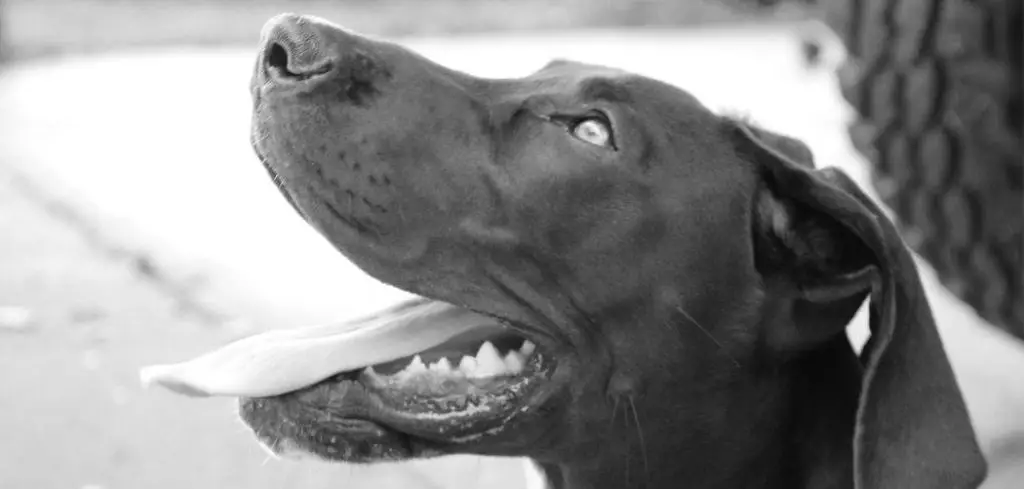When a dog is panting and yelping, it can be alarming for owners, as these signs often indicate discomfort, stress, or an underlying medical issue.
While occasional yelping may be normal during play or excitement, persistent or unexplained yelping combined with panting warrants closer attention.
We outline the common reasons why dogs may pant and yelp, what you can do at home, and when to seek veterinary help.
Dog Panting and Yelping — Why It Happens
When a dog is both panting and yelping, it’s often a sign of pain or distress. Panting can indicate stress, overheating, or difficulty breathing, while yelping usually signals sudden pain or fear.
Together, these symptoms may point to issues like an injury, joint or back pain, gastrointestinal discomfort, or even a reaction to something frightening.

Dog Panting and Yelping: Common Causes
Pain or Injury
Pain is one of the most frequent reasons dogs pant and yelp. Dogs experiencing injuries, such as sprains, broken bones, or joint issues, often vocalize their discomfort with yelps, while panting accompanies the physical stress of pain.
You may notice limping, reluctance to move, or sensitivity when touching specific areas.
Addressing injuries quickly with veterinary care ensures proper healing and prevents worsening of the condition.
Read more: Dog Panting at Night (Why your dog won’t settle)
Anxiety and Stress
Anxious dogs may pant and yelp as a response to stress. Separation anxiety, environmental changes, or loud noises can trigger these behaviors, particularly if your dog feels unsafe or overstimulated.
Other signs include pacing, trembling, whining, and restlessness. Providing a secure, calm environment, and implementing consistent routines can help reduce stress-related panting and yelping.
Gastrointestinal Discomfort
Upset stomach or gastrointestinal issues can cause panting and yelping. Nausea, bloating, or constipation may make your dog restless and vocal as they attempt to find relief.
Watch for vomiting, diarrhea, drooling, or abdominal bloating. Severe or persistent gastrointestinal problems require prompt veterinary attention to prevent complications such as dehydration or blockage.
Heatstroke or Overheating
Overheating is another serious cause of panting and yelping. Dogs unable to cool themselves properly may exhibit rapid, heavy panting, excessive drooling, and yelping from discomfort or distress.
High environmental temperatures, prolonged exercise, or lack of shade and water can contribute. Immediate cooling measures and veterinary care are crucial, as heatstroke can be life-threatening if not addressed quickly.
Respiratory or Heart Conditions
Heart or respiratory issues can manifest as panting and yelping. Conditions like congestive heart failure, respiratory infections, or tracheal collapse make breathing difficult, leading to distress vocalizations and increased respiratory effort.
Signs to monitor include coughing, labored breathing, rapid heartbeat, or blue-tinged gums. Early diagnosis and management from a veterinarian can prevent serious complications.
Dental Problems
Dental pain is a less obvious but significant cause of panting and yelping. Infections, abscesses, or tooth fractures cause severe discomfort, often resulting in vocalization and increased panting due to stress and pain.
Other indicators may include drooling, bad breath, pawing at the mouth, or reluctance to eat. Timely veterinary dental care helps relieve pain and prevent further oral health issues.
Neurological Issues
Neurological problems may also lead to panting and yelping. Conditions such as seizures, vestibular disease, or nerve injuries can cause confusion, disorientation, and pain-related vocalizations.
Observe for trembling, abnormal movements, unsteady gait, or sudden behavioral changes. Neurological issues require immediate veterinary evaluation for accurate diagnosis and treatment.
What to Do If Your Dog Is Panting and Yelping
Provide a calm, secure environment to reduce stress and minimize stimuli that may exacerbate discomfort.
Check for visible injuries or signs of pain, and gently handle your dog to avoid causing further stress.
Ensure your dog has access to fresh water, and monitor for signs of heat stress or dehydration.
Maintain a detailed log of when panting and yelping occur, noting any potential triggers, environmental factors, or accompanying symptoms. This will be helpful for your veterinarian.
If panting and yelping persist despite home care, or are accompanied by concerning symptoms, seek veterinary evaluation promptly for a thorough examination and appropriate treatment plan.
When to Call or Visit Your Vet
Immediate veterinary attention is warranted if your dog exhibits:
Continuous panting and yelping without rest
Signs of severe pain, injury, or difficulty moving
Labored or irregular breathing, rapid heartbeat, or blue gums
Lethargy, vomiting, diarrhea, or abdominal distension
Sudden neurological symptoms, disorientation, or seizures
Prompt intervention ensures timely treatment, prevents worsening of conditions, and alleviates discomfort for your dog.
Read more: Dog panting excessively (Here’s Why)
Key Takeaway
Panting and yelping in dogs is often a sign of pain, stress, or underlying health issues. Observing your dog’s behavior, providing a calm environment, and seeking timely veterinary care are crucial steps to ensure their comfort and wellbeing.
Early detection and management can prevent serious complications, improve your dog’s quality of life, and give you peace of mind.
